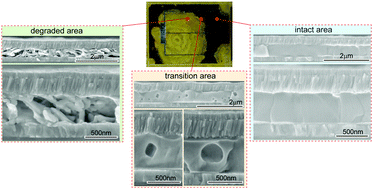I2 vapor-induced degradation of formamidinium lead iodide based perovskite solar cells under heat–light soaking conditions†
Abstract
Over the last years, the operational stability of perovskite solar cells has been significantly improved by compositional engineering, interface modification, and improved encapsulation techniques. However, irreversible degradation is still ubiquitously observed during the first 1000 hours of operation, particularly at elevated temperatures. In this work, we elucidate a major mechanism controlling this degradation. For that, formamidinium lead iodide-based perovskite solar cells were stressed under continuous 1 sun illumination at 80 °C in N2, before extensive characterization of their microstructure and composition. The cell active area and hence the photocurrent are found to decrease with time due to the growth of porous PbI2-rich regions. This degradation was observed to originate from a few seed points in the perovskite bulk rather than from the interfaces with the charge-selective layers or from the cell edges. I2 vapor, first released at these defective points and then further released from the decomposition of the perovskite exposed to this vapor, controls the degradation process. Furthermore, this autocatalytic degradation process is shown to locally rupture the top electrode due to vapor pressure build-up. In addition to highlighting the detrimental influence of residual PbI2, we show that such a degradation pathway can be alleviated by reducing the methylammonium and/or iodine content, providing a path to more stable perovskite solar cells.



 Please wait while we load your content...
Please wait while we load your content...